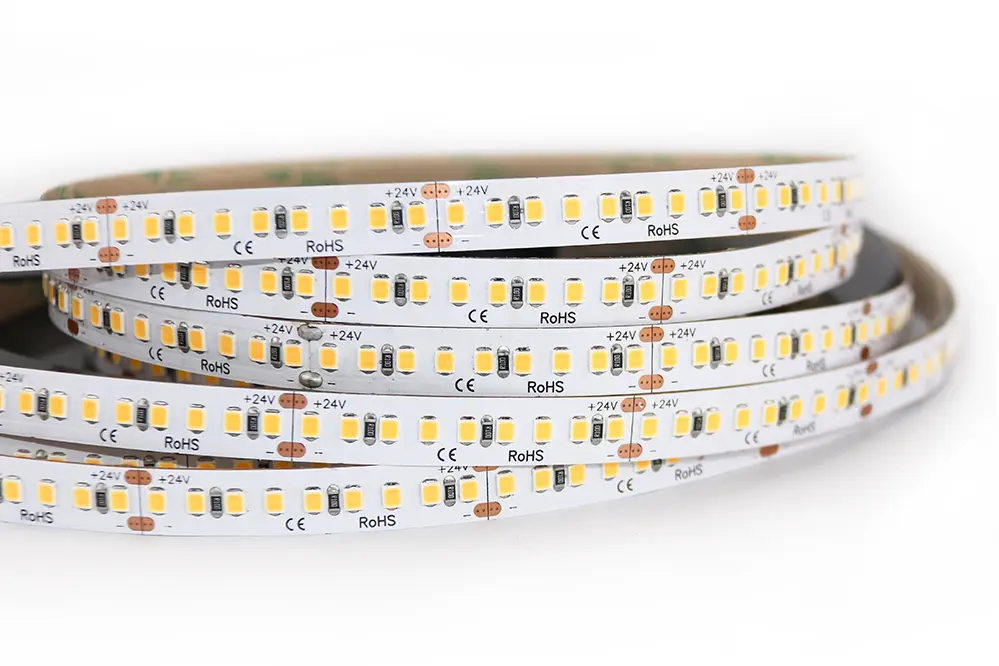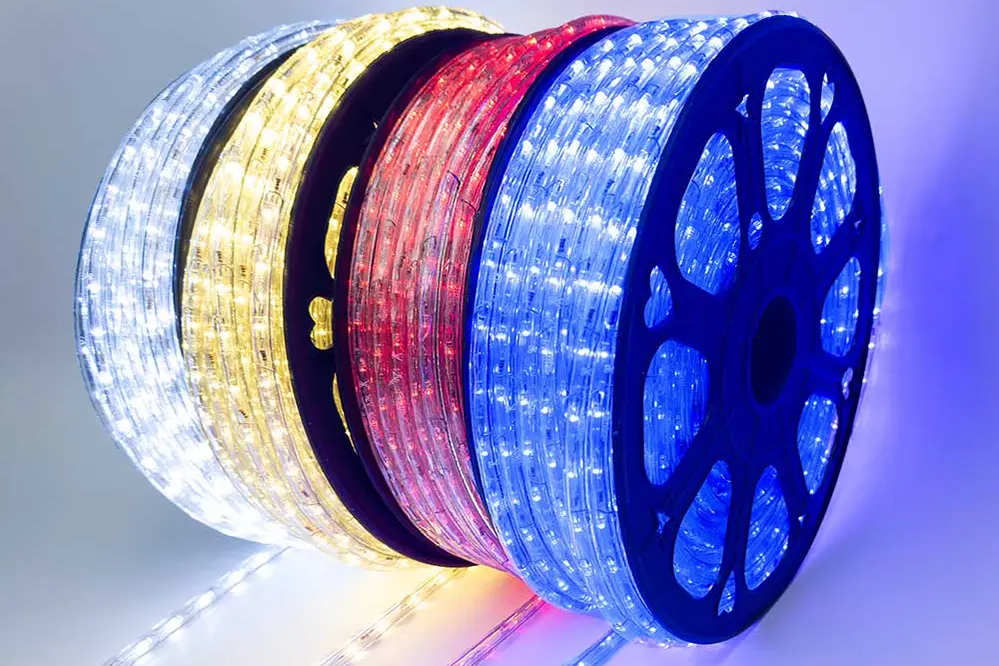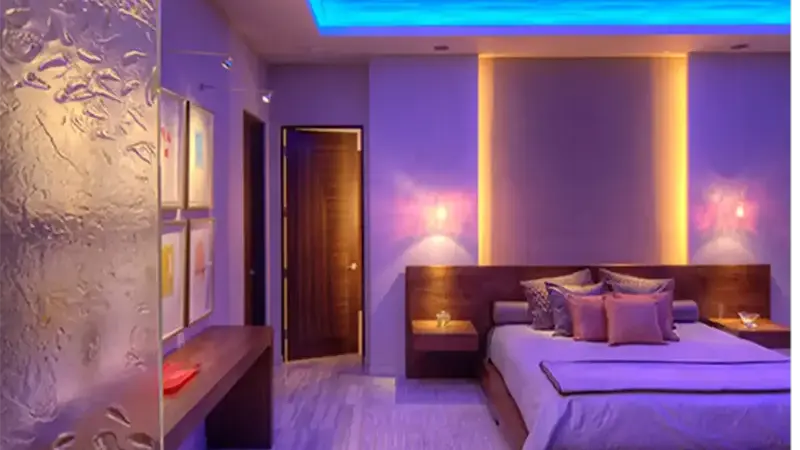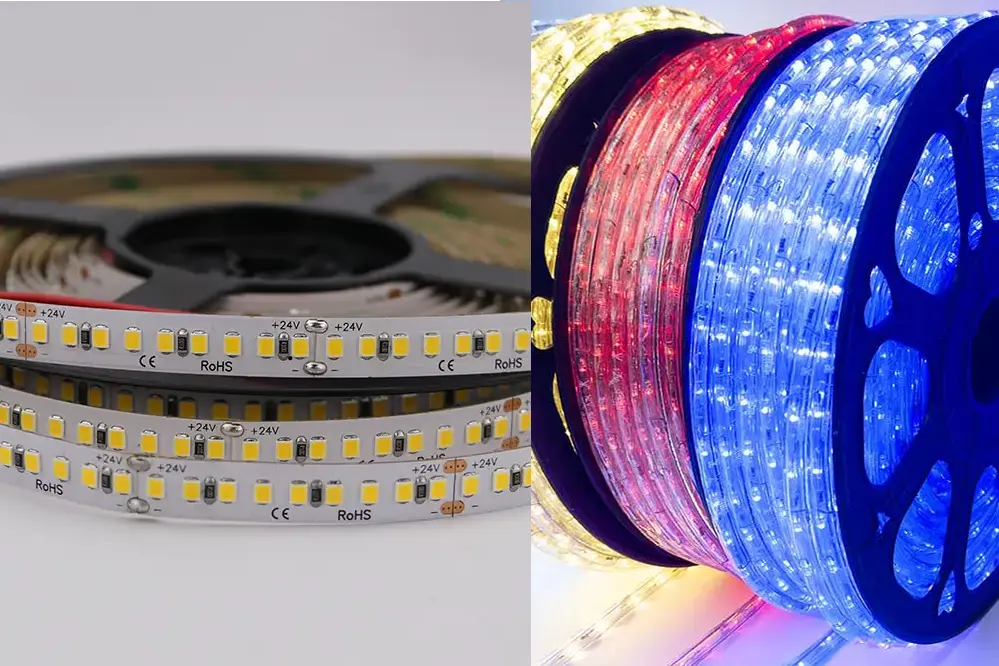Choosing the right lighting solution for your space can be a daunting task, especially with the myriad of options available today. Among the most popular choices are LED strip lights, and rope lights, each offering unique benefits and applications. Whether you’re a homeowner looking to enhance your living room ambiance or a professional seeking the perfect lighting for a commercial project, understanding the differences between these two lighting types is crucial. In this blog post, we will delve into the key features, advantages, and ideal uses of LED strip lights and rope lights to help you make an informed decision.
LED strip lights and rope lights may seem similar at first glance, but they cater to different needs and preferences, with rope lighting adding a cozy, ambient touch. LED strip lights are known for their flexibility, brightness, and energy efficiency, making them ideal for accent lighting, under-cabinet illumination, and creative installations. On the other hand, rope lighting offers durability and ease of installation, often used for outdoor decorations, pathway lighting, and festive displays. By comparing these two options, we aim to provide you with a comprehensive guide that highlights their distinct characteristics and helps you choose the best lighting solution for your specific requirements.
My name is Tom, and I’ve been immersed in the LED lighting industry since 2005. With nearly two decades of experience, I’ve witnessed the evolution of LED technology and have developed a deep understanding of its various applications. My expertise particularly lies in LED strip lights, and I am passionate about sharing my knowledge with others. This blog post is a culmination of my extensive research and hands-on experience, aimed at providing you with valuable insights and practical advice on choosing between LED strip lights and rope lights.
So, if you’re ready to illuminate your space with the perfect lighting solution, let’s dive right in! Explore the following sections to discover the pros and cons of each lighting type, and find out which one best suits your needs.
Differences in Design

LED strip lights, otherwise known as tape lights, consist of close-packed LED modules that provide high flexibility and brightness, making them apt for various design applications.
On the other hand, rope lights typically encase LED or incandescent bulbs within a thick, cylindrical PVC or silicone tube, which lends them more durability but less flexibility compared to LED strip lights.
Due to their construction, LED strip lights can achieve more intricate designs.
Flexibility and Form
LED strip lights offer unmatched versatility, making them ideal for intricate installations. These lights can be easily bent and cut to fit any desired length.
In contrast, rope lights have a more rigid form, limiting their application flexibility. They are better suited for less complex setups where straight lines dominate.
LED strips can bend around corners seamlessly.
When choosing between the two, consider the specific needs of your space. If you require custom shapes or contours, LED strip lights are preferable, providing high adaptability and precision. For simpler layouts, rope lights deliver a consistent, straightforward form factor.
Aesthetic Appeal
LED strip lights excel in providing high-definition, vibrant illumination that enhances modern décor elements.
These lights come in various colors, color temperatures, and RGB options, offering customization to match any interior design palette. Their slim profile seamlessly integrates into tight spaces.
In addition, LED strip lights can be used to create dramatic effects, such as under-cabinet lighting, cove lighting, or accentuating architectural features. Their adhesive backing simplifies installation.
Conversely, rope lights exude a nostalgic charm reminiscent of older, classic lighting styles. They emit a gentle, diffused glow, making them ideal for creating cozy, ambient settings.
Both lighting options have unique aesthetic strengths, so your choice should reflect your desired ambiance.
Installation Process

LED strip lights’ installation typically involves, at minimum, an adhesive backing, making them easy to attach to most surfaces. Additional mounting options like clips or channels can provide extra security and stability, particularly in uneven areas.
Conversely, rope lights often require a more hands-on approach, usually involving the use of “mounting clips.” These clips need to be screwed or nailed into place, ensuring firm adhesion. Given their flexible but bulky design, the installation of rope lights tends to be more labor-intensive and demands careful handling to avoid damage.
Ease of Setup
LED strip lights offer a straightforward installation process, largely because of their adhesive backing that allows for simple attachment to a variety of surfaces.
This adhesive preparation requires minimal tools and effort, making it accessible even for do-it-yourself enthusiasts.
Additionally, the low-profile nature of LED strip lights means they can be seamlessly integrated into tight spaces or along edges.
Because of their flexibility, LED strip lights can also be effortlessly customized in length using scissors or specialized connectors.
In contrast, rope lights require a more labor-intensive setup procedure. These typically involve mounting clips that need to be screwed or nailed into place.
The rigidity and bulkiness of rope lights add another layer of complexity. Thus, they often demand more time and careful planning to ensure a stable, damage-free installation.
Ultimately, the ease of setup for LED strip lights makes them a preferred choice for quick and adaptable installations. Conversely, rope lighting, despite its charm, necessitates a more resource-intensive approach.
Tools Required
When setting up LED strip lights, you will need a few essential tools to ensure a smooth installation.
Primarily, you will need a pair of scissors for trimming the strips to the desired length.
More advanced setups may necessitate specialized connectors and a soldering iron for precise joins and modifications, depending on the complexity of your project.
On the other hand, installing rope lights generally requires a different set of tools. Typically, you will need mounting clips, screws, and a screwdriver or drill. In some cases, it might also be beneficial to have a tape measure and a level to ensure uniform and secure placement. As such, preparation and attention to detail are key for a successful rope light installation.
Lighting Performance

LED strip lights offer unparalleled versatility in terms of color temperature and brightness levels. Their highly customizable nature allows for precision control, creating any ambiance required, from warm, relaxing hues to bright, task-oriented lighting.
Rope lights, in contrast, generally have a more limited range of colors and brightness options, making them suitable for accent lighting rather than primary illumination.
Brightness Levels
When choosing between LED strip lights and rope lights, brightness levels are a crucial factor to consider.
- LED strip lights: High brightness, customizable, and dimmable.
- Rope lights: Lower brightness, generally not dimmable.
LED strip lights offer superior luminosity and are often more suitable for task lighting or high-visibility areas.
Conversely, rope lights, with their softer glow, may be better suited for accent lighting, creating ambiance rather than providing primary illumination.
Energy Consumption
One of the primary factors to consider when choosing between LED strip lights and rope lights is energy consumption.
LED strip lights are highly energy-efficient, using advanced technology to produce high lumens per watt.
Typically, LED strip lights consume around 7 to 10 watts per meter, depending on the brightness and run length.
In comparison, rope lights generally use more energy, around 12 to 15 watts per meter.
When planning a lighting installation, it’s crucial to assess the overall energy consumption, especially for larger projects.
Ultimately, if energy efficiency is a top concern, LED strip lights often offer better performance.
Best Use Cases
LED strip lights excel in spaces requiring direct, high-intensity illumination, such as under-cabinet lighting, workspaces, or display cases. Their flexibility and adhesive backing make them ideal for intricate installations. Conversely, rope lights are highly effective for outdoor decorations or ambient lighting in areas like patios or pathways, where a softer, diffused light is preferred. Both options offer unique advantages depending on the specific lighting needs and aesthetic goals of the environment.
Indoor Applications
When it comes to indoor lighting, both LED strip lights and rope lights offer unique advantages depending on the application.
Rope Lights
- Ambient Room Lighting: Creates a relaxing atmosphere.
- Cove Lighting: Adds a soft, diffused glow.
- Closets and Pantries: Offers sufficient illumination without harshness.
- Decorative Elements: Suitable for festive decorations and events.
LED strip lights excel in precision-focused applications, making them ideal for task lighting scenarios.
Rope lights are better suited for creating gentle, diffused lighting effects that enhance ambiance.
Outdoor Applications
Outdoor lighting has unique requirements.
LED strip lights are excellent for architectural accentuation. They can be used to outline the edges of structures or pathways, significantly enhancing both aesthetics and safety. Furthermore, due to their directional light output and versatility, they are well-suited for highlighting garden features or outdoor art installations.
Rope lights excel in creating ambient lighting.
These lights are often used for perimeter lighting or to create festive atmospheres in outdoor spaces. The circular diffusion of light ensures a soft glow that is less likely to cause glare or harsh shadows, making them ideal for social gatherings or relaxed outdoor settings.
When considering weather resistance for your outdoor lighting, both LED strip lights and rope lights come in options that are rated for outdoor use, including waterproof and UV-resistant varieties. LEDs, however, tend to have better energy efficiency. Properly installed outdoor lighting can dramatically elevate your outdoor environments while maintaining energy efficiency and longevity.
FAQs
Which is better, rope light or strip light?
The choice between rope lights and strip lights hinges on the specific requirements and aesthetics of the project at hand. Both types of lighting solutions have their unique strengths and use cases.
Rope lights, encased in a durable and flexible plastic tubing, are typically more suitable for outdoor and heavy-duty applications. They are particularly effective for accentuating architectural features, landscaping elements, and festive decorations due to their robustness and ease of installation, especially in curved spaces.
On the other hand, strip lights, also known as LED tape lights, offer greater versatility in terms of customization. They provide a slimmer and more discreet profile, allowing for installation in tighter spaces and more intricate designs. Strip lights are preferred in applications that demand higher brightness levels and color-changing capabilities, such as under-cabinet lighting, backlighting for displays, and creative DIY projects.
Ultimately, the decision between rope lights and strip lights will depend on project-specific factors, including the desired luminosity, ease of installation, environmental conditions, and budget constraints. Each option offers distinct advantages that can be leveraged to enhance the ambiance and functionality of the lighting design.
What are the disadvantages of rope light?
Rope lights, while versatile and aesthetically pleasing, come with several drawbacks that need to be considered for effective implementation.
First, rope lights often suffer from limited brightness compared to other types of lighting such as LED strips or traditional light bulbs. This can restrict their use in settings where more illumination is required, such as task lighting scenarios.
Additionally, the heat dissipation of rope lights is notably less efficient. The lack of adequate ventilation can lead to a rise in temperatures, which not only reduces the lifespan of the lights but also raises potential safety hazards. Therefore, it’s crucial to avoid using them in confined spaces without proper airflow.
Rope lights are also known for their rigid form factor. Unlike LED tape lights that are flexible and can adhere to various surfaces and shapes, rope lights are less adaptable, limiting design creativity. This can be a significant disadvantage in intricate installations or tight spaces.
Furthermore, their installation and maintenance can be more labor-intensive. Connecting segments and ensuring they remain weatherproof, particularly for outdoor use, requires extra effort. The sealing of ends and connectors adds an additional layer of complexity, posing challenges for both professional installers and DIY enthusiasts alike.
Can you leave LED rope lights on all night?
LED rope lights are a highly efficient and versatile lighting solution. Their allure stems from not just their aesthetic appeal but also their energy efficiency and safety features.
Energy-efficient LED technology ensures minimal heat output, which significantly reduces the risk of overheating or fire hazards. This makes overnight use generally safe.
Additionally, the longevity and low energy consumption attributes of LEDs make them ideal for continuous operation. These features reduce the need for frequent replacements and minimize energy costs.
When installing and using LED rope lights for extended periods, always follow manufacturer guidelines and recommendations. Proper installation with the appropriate power supply and adhering to safety codes will ensure optimal performance and safety.
Do LED rope lights use a lot of electricity?
LED rope lights are known for their energy efficiency. They consume significantly less power compared to traditional incandescent or fluorescent lighting options.
Typically, LED rope lights use about 0.1 watts per LED. Considering an average rope light strand may have around 150 LEDs, the total power consumption is still quite minimal.
This reduced energy consumption not only translates to lower electricity bills but also supports sustainable living. One could operate multiple strands of LED rope lights and still consume less electricity than a single incandescent bulb.
Moreover, LED rope lights have a longer lifespan and are more environmentally friendly, reducing the frequency of replacements. Consequently, they offer both economic and ecological benefits, making them a prudent choice for both residential and commercial applications.
Are led strip lights easier to install than rope lights?
Yes.
LED strip lights generally incorporate a self-adhesive backing, making them particularly simple to mount on a variety of surfaces. Their flexibility and thin profile lend themselves well to applications that require contouring, such as under cabinets or along architectural lines.
Indeed.
In contrast, rope lights often require specialized mounting clips or channels, adding a layer of complexity. The circular cross-section of rope lights can also limit their use in tight or angular spaces where a flatter profile would be more practical.
That’s not all.
Connection systems for LED strip lights are frequently designed with plug-and-play ease. Rope lights, however, might necessitate more intricate wiring connections, sometimes even requiring the services of an experienced electrician.
Installation aside.
Performance factors such as energy efficiency and brightness uniformity further tip the balance in favor of LED strip lights. Given these advantages, it becomes clear why LED strip lights are often the preferred choice for modern lighting projects.
Do led strip lights provide more customizable options?
LED strip lights have revolutionized the lighting industry with their versatility.
These lights offer extensive color options, enabling you to tailor your lighting to any ambiance or mood. With RGB and RGBW variants, users can mix and match millions of colors seamlessly.
Additionally, LED strip lights can be dimmable, allowing for precise control over brightness levels. This flexibility makes them suitable for both functional and decorative applications.
Customization extends to the physical configuration as well. LED strips can be cut to length, mounted at various angles, and integrated into complex architectural designs efficiently.
In conclusion, the adaptability of LED strip lights in color, brightness, and physical arrangement sets them apart from traditional lighting options.
How do the costs of led strip lights compare to rope lights?
When evaluating cost efficiency, LED strip lights and rope lights present distinct considerations. Generally, LED strip lights tend to be more expensive initially due to their advanced technology and increased flexibility in applications. These strips often come with higher initial purchase prices, particularly when you factor in the cost of additional accessories like controllers and power supplies.
Conversely, rope lights are typically less expensive up front. Their straightforward design and ease of installation contribute to their lower cost, especially for consumers looking for a quick and robust lighting solution.
In the context of operational costs, LED strip lights offer significant long-term savings despite the higher initial investment. Their energy efficiency and durability mean reduced electricity expenses and less frequent replacements.
On the other hand, rope lights, while more affordable initially, may accrue higher expenses over time due to their lower energy efficiency and shorter lifespan.
Moreover, LED strip lights provide a higher lumen output per watt and superior lifespan compared to rope lights. This means they offer brighter, more vibrant illumination while consuming less energy.
Thus, for professionals and lighting enthusiasts prioritizing long-term cost-effectiveness and performance, the higher upfront cost of LED strip lights is often justified. However, for those with budget constraints or for less demanding installations, rope lights present an appealing option.
Which type of lights is more durable: led strip or rope lights?
When assessing durability, LED strip lights typically outperform rope lights due to several factors, such as build quality and technological advancements.
LED strip lights are constructed with a more robust PCB backing, which enhances their longevity.
Moreover, LED strips often have better heat dissipation technologies, mitigating potential degradation over time.
However, rope lights, while flexible and often more affordable, generally have less sophisticated assembly and can be prone to wear and tear more quickly, especially in outdoor environments subjected to weather elements. For critical applications requiring long-term reliability, investing in high-quality LED strip lights is usually the better option.
Conclusion
Choosing between LED strip lights and rope lights ultimately depends on your specific application needs. Since 2016, advancements in lighting technology have significantly improved the performance and versatility of both options, catering to various aesthetic preferences and functional requirements. LED strip lights offer superior customization and brightness, making them ideal for detailed workspaces or modern architectural accents, while rope lights excel in creating a smooth, diffuse glow perfect for ambient and festive lighting scenarios. Evaluate the unique demands of your space, whether indoor or outdoor, and consider the brightness, flexibility, and aesthetic impact you desire. By doing so, you can make an informed decision that will enhance the functionality and visual appeal of your environment. Ultimately, both lighting options provide excellent opportunities for creative and energy-efficient illumination.
For those looking to source high-quality LED strip lights and LED neon strips, consider reaching out to Unitop, a professional Chinese manufacturer renowned for their expertise and innovation in LED lighting solutions. With a commitment to excellence and a wide range of products, Unitop can help you find the perfect lighting solution tailored to your needs. Contact Unitop today to explore their offerings and elevate your lighting projects to new heights.





